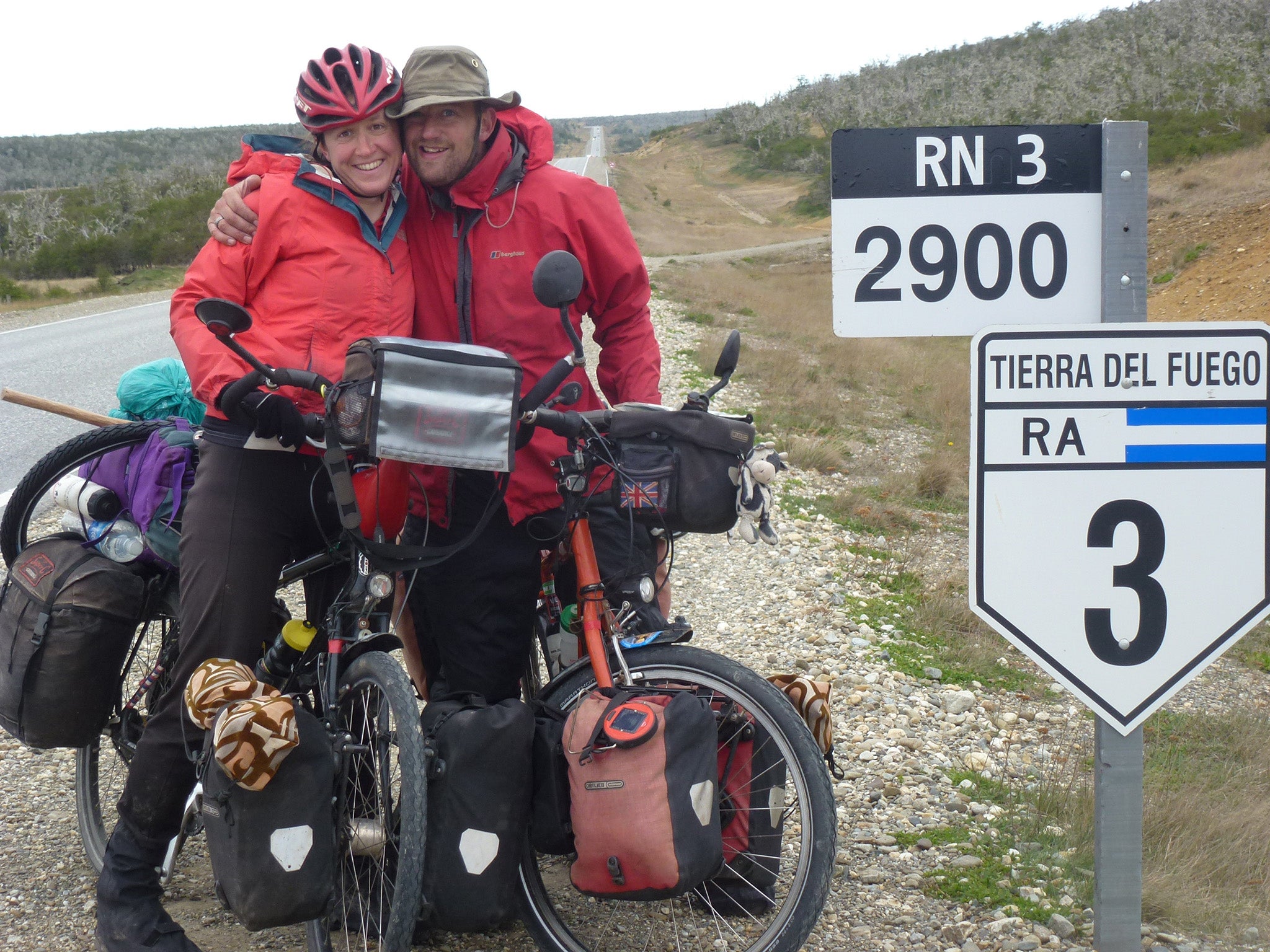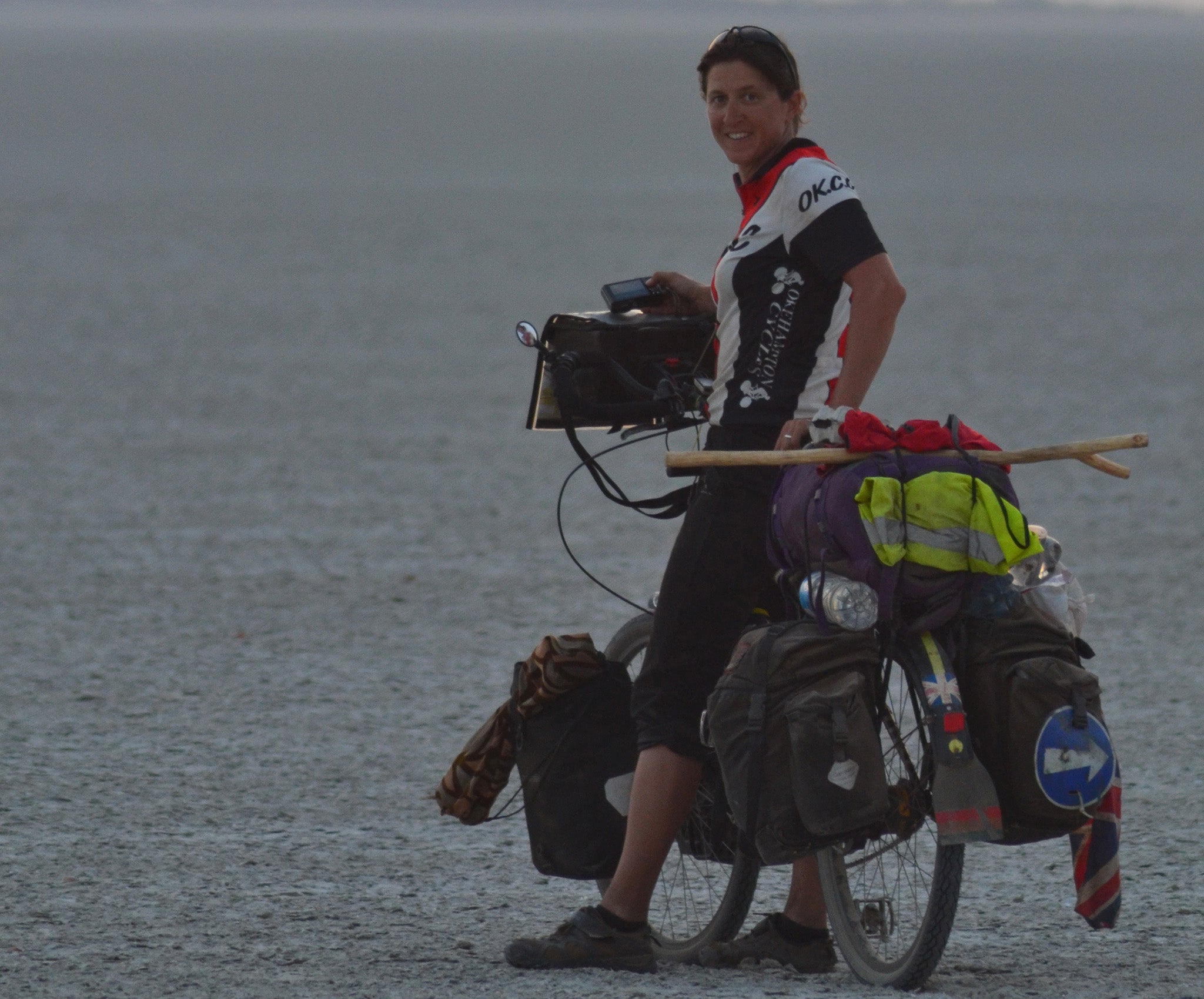Why I continued my round-the-world cycling trip even after losing my wife on the journey
Tim Bridgman and his wife Sharon were fulfilling their dream of a round-the-world cycling trip when she was killed suddenly on the road - he explains why he felt compelled to carry on the journey without her

Tim Bridgman is sitting in a café in Huaraz in central Peru. He is 23,050 miles into a round-the-world cycle, and has another 12,000 miles to travel north to Alaska. It’s a journey that he started with his wife Sharon, but will complete alone. On 26 April 2014, after pedalling thousands of miles through Europe and Africa, she was killed on the road in Bolivia.
Tim, 41, went to school with Sharon near Exeter, but they only became friends in their early twenties, getting together as a couple a few years later. They married when Tim was 30 and Sharon 28, in Cadbury, Devon. “We’ve been to 42 different countries together,” Tim says. “When I first got to know Sharon she’d just come back from Gambia, and was working at a school for the visually impaired in Exeter.”
In 2007, the couple were training for a marathon when Sharon slipped three discs in her back, and was unable to walk for seven months. “I didn’t think she’d ever be able to ride again,” Tim remembers. “She had injections in her spine and she overcame it, even with impact sports like dancing. She never seemed to let anything stop her. And she’d find the challenge in everything: it was amazing to have someone so motivated and motivating when in pain.”
And so, after a long, slow recovery, when Tim confided in Sharon his dream to cycle the world, they set about taking on the 30,000 mile challenge. They went on a three-week test run in 2010 and cycled the length of Vietnam. “We had no conversation skills in Vietnamese but were being invited into people’s homes, communicating with pidgin English and sign language,” Tim says. They were hooked, and after planning a route starting and ending in the Arctic Circle, they gave up their jobs as a carpenter and manager of a drug project in May 2012, and set off on 4 June with their bikes.
Their journey started in Nordkapp in Norway. “There was 24 hours of sunlight,” Tim remembers. “Quite often, we’d be riding at midnight, and it would feel like the hour before sunset on a summer’s evening. We’d look into fjords where ships looked like they were the size of a toy boat in a bath, surrounded by mountains.”
They travelled down through Scandinavia and eastern Europe, “Romania felt like a medieval, mystical romantic country”, into Turkey, Cyprus, Egypt. “We experienced nothing but kindness. Between Alexandria and Cairo, a guy showed us pictures of first him, and then his mum, in full burkha, firing an AK-47 into the air. We learnt it was for a wedding, a sign of celebration. That night we camped in the bush, and we’d heard lots of beeping of horns, so when we heard gunfire we knew there was a wedding close by. It was nice to understand the context.”

They continued to travel south through east Africa. “The hardest place was Ethiopia,” Tim remembers. “We were stoned by kids constantly, which is the way many people their control animals... We were hounded, sometimes we couldn’t rest.” Further south, they were found by anti-poaching police and were taken to a secure military camp on the border of Burundi and Tanzania. They cycled on to Cape Aghulus in South Africa, a trip of 15,939 miles. From there, they flew to Buenos Aires and travelled from the southern tip of Argentina into Bolivia.
“The longer we spent together, the stronger we got,” Tim says. “We were so attuned to what each other needed. We were always within sight of each other – I’d only go ahead if I wanted to take pictures of Sharon coming up a pass. We helped each other out when we were tired – it wasn’t easy being on the road. If there was a problem, we’d talk about it and would come to a compromise. We moulded into the cycling lifestyle with ease, it became comfortable for us. If Sharon was low – she’s close to her family and would miss them – I’d pick her up and she’d do the same for me. We balanced each other out. Things don’t feel as dramatic together.”
But, on 26 April 2014, cycling along an empty road in south west Bolivia, Sharon’s journey ended. The only car they’d seen on the road that day knocked her down. She died.
Tim writes in his blog of his trip back to England, still in shock over Sharon’s death. Sitting in the airport, boarding pass in hand, expecting her to appear and take it off him at any moment in exasperation – as she always does – to stop him folding the corners – as he always does. “So many people see the little things as faults, but they’re the gems that make us who we are,” he says.
Tim sonn realised that he had to complete the ride in memory of Sharon. “Before I even left Bolivia, I knew I had to return. I have the most incredible friends and family. I’d been cycling for two years, in a different environment, and within days I was on a plane home. It was so unexpected, so hard for me to comprehend or start to get my head around. For me to come to terms with it, I knew I had to come back. If I gave up, then what was the point of starting it when I’ve lost her? And cycling around the world, you see what people don’t have.”
After 10 months at home, surrounded by family and friends, he returned to Bolivia, and to the site where Sharon died, aged 38. “It doesn’t make sense,” he says. “We cycled across four-lane roads into Istanbul, roads with the highest concentration of lions. But it was on a road so quiet. In Bolivia, if a road wears out they just plough another one next to it, and there were three parallel roads. It was the only car to go down the road in the six hours we were on it. It is hard to know why it happened. Especially to someone who would give so much to others.”
He is conscious of Sharon every day on the road. “We had our little routines,” he remembers. “Sharon would put the kettle on while I pitched the tent. I miss sharing stuff. When I’m in nature, I don’t feel alone, because I’m surrounded by so much. But when I see an incredible sunset, it makes it more incredible to know it was shared. And to know I’ve shared those moments with Sharon will always be special.”
He says his blog is now a way to share those “snippets” with those he cares for. “When I’m sweating up a hill and round a corner to see a snow-capped mountain, or am cycling along and a giraffe pops out. That’s what it’s about, sharing experiences, sharing everything.” On his 100th blog post, he shared photos of incredible, towering clouds, funnelling up to the sky that they saw on their ride together.
He has the support of his and Sharon’s family (including his seven-year-old niece, who has just completed a charity bike ride to raise funds for Shelterbox in Sharon’s memory) and his friends, a succession of whom are visiting to join him for parts of the journey. “Our dreams start as children,” he says. “Cycles round the block, picnics, they inspire us later in life. Sharon was incredible at seeing into the future: she’d see Mount Everest and want to climb it, not for the summit but for the journey.”
And as he pedals on, in memory of his wife’s motivation, he approaches the ride a day at a time. “Regret is a wasteful emotion,” he says. “I remember, when we were setting off, there was a map on the wall for our leaving do, and I didn’t want to show people the route because it looked so massive. But it’s just a series of days to take, step by step.”
Tim Bridgman blogs at north2northcycletour.wordpress.com
Join our commenting forum
Join thought-provoking conversations, follow other Independent readers and see their replies
0Comments